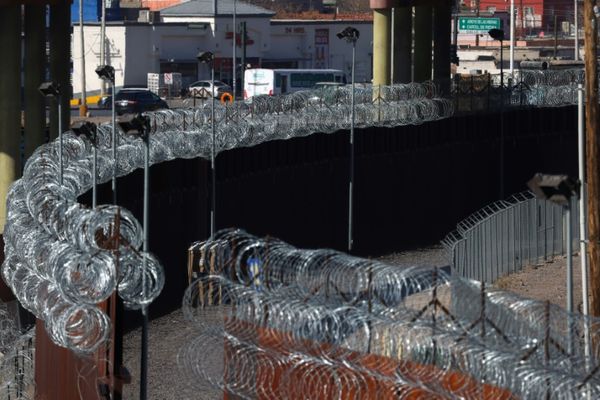
For many Murdoch-watchers, last week’s US$787.5 million settlement of Dominion’s lawsuit against Fox News has robbed the world of a riveting courtroom drama.
A big question had been whether the 92-year-old Fox Corporation chairman Rupert Murdoch would be testifying. What might it have looked like if he had fronted the Delaware courthouse? From the earliest years of the Murdoch empire as we know it, Rupert’s appearances under oath have been rare but revelatory events.
One of the first came in late January 1960, when the 28-year-old fronted a courtroom in Adelaide, South Australia. Upon arrival, Murdoch gave his occupation as “journalist” to the court stenographer, but when the Crown lawyer asked if had also been performing the role of News Limited’s managing director in August and September the previous year, Murdoch declined to answer — “on the grounds that it might tend to incriminate me”.
Murdoch’s stonewalling came as News Limited faced one of its biggest crises since Rupert inherited the company from his father, Sir Keith, in 1952. Months earlier, its afternoon paper The News had published a front-page report and a handful of newsstand posters covering a dramatic walkout in the Stuart royal commission. The inquiry was supposed to re-examine the 1959 murder conviction of Arrernte man Rupert Max Stuart, whose death sentence hinged on a signed confession of contested authorship, and came after The News and its editor Rohan Rivett — a social justice warrior by 1950s standards — helped bring international pressure upon the state government to reopen the case.
But a few days into the royal commission, Stuart’s lawyer Jack Shand QC abruptly withdrew after being interrupted during cross-examination by royal commissioner chief justice Mellis Napier. Controversially, Napier had previously presided over one of Stuart’s earlier failed appeals — and had dismissed claims that police had beaten the confession out of Stuart as “rubbish”. That afternoon in August 1959, The News’ headlines boldly declared “These Commissioners Cannot Do The Job” and “Commission Breaks Up — Shand Blasts Napier”.
For seven years, The News had been rocking the boat in mid-century Adelaide, where the influence of rival morning daily The Advertiser and Liberal Country League premier Sir Thomas Playford had been unchallenged for decades. Both Murdoch and Rivett had faced threats of libel and contempt since they’d moved to Adelaide, but when police officers entered News Limited’s North Terrace headquarters in early January 1960 to question Rivett, and later Murdoch, it seemed this was one crusade too far. By the end of the month, the company and its editor were facing trial for nine counts of libel, including the rare charge of seditious libel.
In court, News Limited’s journalists and its “boy publisher” tried their best to stare down the Crown’s efforts to uncover who was responsible for the August coverage. The questioning often descended into farce — two News Limited journalists were placed into custody for refusing to answer, while another was granted immunity from prosecution to compel him to talk.
Their eventual testimonies offer a rare insight into the inner workings of early News Limited, and how the afternoon newspaper model that formed the foundation of Murdoch’s small empire was, in some ways, structurally disposed to sensationalism. Unlike morning papers, they had to earn every sale with juicy headlines and front-page stories that grabbed the attention of passers-by. It was clickbait for the post-war era, and the ensuing debate even foreshadows recent cases like the Twitter-centric Dutton vs Bazzi (“My submission is that the poster would be so connected [to the article] that it would be wrong to treat it alone as defamatory,” Rivett’s lawyer argued in 1960.)
In the dock, Rupert continued to duck questions, but as the case progressed the logic behind the initial strategy of silence became clear: Rivett and the company might have been facing the charges, but it was Rupert himself who had composed two of the headlines cited by the Crown. Furthermore, a subsequent editorial that had sought to walk back some of their claims — “The headline should never have been published and we regret that it was,” it read — had also been drafted by Murdoch. But at trial, what seemed to be an attempt at de-escalation in the face of government pressure was brandished by the Crown as an admission of fault.
The “Poison Pen Libel Trial” ended in a bittersweet win for News Limited; the judge threw out the seditious libel counts, while the jury eventually rejected all but one of the remaining charges. The final count hung over Rivett for months, until it was dropped just weeks before Rupert sacked his old friend and longtime editor via letter (Jerry Hall can probably relate). Rupert had turned his focus to Sydney, where he promised readers of his latest acquisition to expect “a lack of bias” and “a more factual and sincere approach to reporting” — foreshadowing the “Fair and Balanced” mantra made infamous by Fox News.
A lot has changed between that courtroom in Adelaide and this week’s developments in Delaware. Murdoch might have left the progressive crusades of those early years behind, but both cases show that in moments of great crisis, Rupert — still regarding himself as a “journalist at heart” — is never far from the action. And as the slightly conciliatory depositions he made in January attest, even he sometimes recognises when his companies have flown too close to the sun.
Young Rupert: The Making of the Murdoch Empire by Walter Marsh is out on 1 August.







